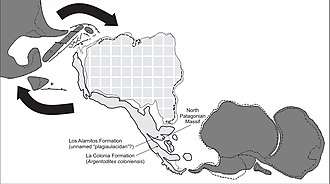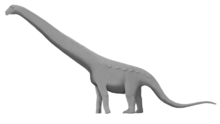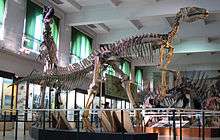Los Alamitos Formation
The Los Alamitos Formation is a geological formation of the North Patagonian Massif in Rio Negro Province, northwestern Patagonia, Argentina, whose strata date back to the Late Cretaceous (Late Campanian to Maastrichtian). Dinosaur remains are among the fossils that have been recovered from the formation.[1]
| Los Alamitos Formation Stratigraphic range: Late Campanian-Maastrichtian ~85–66 Ma | |
|---|---|
| Type | Geological formation |
| Sub-units | Coli Toro Member |
| Lithology | |
| Primary | Siltstone |
| Other | Sandstone |
| Location | |
| Coordinates | 42.1°S 66.3°W |
| Approximate paleocoordinates | 45.0°S 52.3°W |
| Region | Río Negro Province |
| Country | |
| Extent | North Patagonian Massif |
 Los Alamitos Formation (Argentina) | |
Fossil content

Paleogeography of the Late Cretaceous with Los Alamitos Formation indicated
Dinosaurs
| Non-avian Dinosaurs reported from Los Alamitos Formation | ||||||
|---|---|---|---|---|---|---|
| Genus | Species | Material | Notes | Images | ||
| Aeolosaurus | A. rionegrinus |  | ||||
| Secernosaurus (="Kritosaurus" australis) | S. koerneri | "Partial skulls with associated postcrania, approximately [five] individuals." |  | |||
| Indeterminate theropod | ||||||
Birds
| Birds reported from the Los Alamitos Formation | ||||||
|---|---|---|---|---|---|---|
| Genus | Species | Material | Notes | Images | ||
| Alamitornis | A. minutus | |||||
| cf. Hesperornithes | ||||||
| Indeterminate Ornithurine | ||||||
| Indeterminate Avian | ||||||
Mammaliaforms
| Mammaliaforms reported from the Los Alamitos Formation | ||||||
|---|---|---|---|---|---|---|
| Genus | Species | Material | Notes | Images | ||
| Alamitherium | A. bishopi | |||||
| Austrotriconodon | A. sepulvedai A. mckennai |
|||||
| Leonardus | L. cuspidatus | |||||
| Bondesius | B. ferox | |||||
| Brandonia | B. intermedia | |||||
| Casamiquelia | C. rionegrina | |||||
| Ferugliotherium | F. windhauseni | |||||
| Gondwanatherium | G. patagonicum | |||||
| Groebertherium | G. novasi | |||||
| Mesungulatum | M. houssayi | |||||
| Paraungulatum | P. rectangularis | |||||
| Reigitherium | R. bunodontum | |||||
| Rougiertherium | R. tricuspes | |||||
gollark: It's not really that good, but it's generally better than randomly giving one group more power.
gollark: I mean, that is the intention of having a democracy.
gollark: Maybe you should be.
gollark: You could just directly make voting power be proportional to land area and it would be more efficient and simple.
gollark: Especially like this.
See also
- List of dinosaur-bearing rock formations
References
- Weishampel, David B; et al. (2004). "Dinosaur distribution (Late Cretaceous, South America)." In: Weishampel, David B.; Dodson, Peter; and Osmólska, Halszka (eds.): The Dinosauria, 2nd, Berkeley: University of California Press. Pp. 600-604. ISBN 0-520-24209-2.
- Prieto–Marquez, Alberto; Salinas, Guillermo C. (2010). "A re–evaluation of Secernosaurus koerneri and Kritosaurus australis (Dinosauria, Hadrosauridae) from the Late Cretaceous of Argentina". Journal of Vertebrate Paleontology. 30 (3): 813–837. doi:10.1080/02724631003763508.
- "Table 20.1," in Weishampel, et al.
- Bonaparte, 1999
- Bonaparte & Soria, 1985
- Bonaparte, 1990
This article is issued from Wikipedia. The text is licensed under Creative Commons - Attribution - Sharealike. Additional terms may apply for the media files.